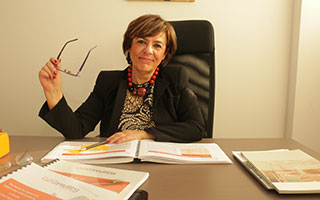Steady growth ahead

What does the market situation in the copper industry look like today, and how can we prepare for tomorrow in times of rapid change? We sat down with Monica Di Cosimo, the Co-Founder and Partner of Cu2 Consulting, an independent research consultancy specialising in the copper industry.
Over the last few years we’ve experienced various surprises in the global situation – and not all of them have been pleasant.
What does the market situation in the copper industry look like today, and what is to be expected in the near future?
Let’s turn to Cu2 Consulting, an independent research consultancy specialising in the copper industry, markets, and products. Cu2 Consulting produces reports on the market situation, news, and other hot topics in the industry.
– We offer our clients multi-client regular reports and studies, as well as specialist support through client projects tailored to the specific needs of individual companies, Co-Founder and Partner Monica Di Cosimo elaborates.
The consultancy focuses primarily on copper fabrication.
– The objective of our tailor-made projects is to support our customers in their business and strategic development, whether they want to enlarge their presence in a given market, enter a new geographic market or a new segment, start offering new products, make investments to expand or find suitable M&A targets.
These are comprehensive and complex projects that often involve market sub-segments with no existing data. That is why field research is much needed.
– We help our clients to understand and interpret the market supply and demand, including development trends, assess their own positioning, and choose the development options that are best suited to their situation, profile, and objectives, Di Cosimo explains.
Speaking the language of the industry
Monica Di Cosimo says that Cu2 Consulting provides at least two types of value for their clients. The first one is related to the specific situation in the industry.
– In the copper industry, there is no objective sector-specific data, as there may be in other sectors. For example, cars are being registered by brand in the automotive industry. Some organisations provide estimates or collect data from certain copper companies and use them to produce aggregate figures. Still, in many cases, the data collection and coverage are quite partial, and the aggregate release of figures occurs with a considerable time lag. Also, some double-counting may occur for large cross-national groups.
– Instead, having up-to-date and specific sector data is crucial for decision-making. We address this need and fill the data gap, Di Cosimo explains.
The second value is based on Cu2 Consulting’s background, experience, and knowledge of the industry.
“For the long term, we are extremely optimistic.”
– The two co-founding partners, Roberta Novello and myself, have been involved in the copper fabricating industry, working for several decades for one of the major copper fabricators. This hands-on experience has allowed us not only to know the market from the industry perspective, but also to “speak the language of the industry” and understand its needs.
Since the establishment of Cu2 Consulting in 2014, the company has been working side by side with several major copper fabricators in Europe, North America, Latin America, and Asia, supporting them in their strategy and development.
– This has helped broaden our expertise and strengthened the reliability of our service, Di Cosimo adds.
The importance of Asia is growing
The copper industry interacts with countless fields. The Europe-based copper consultancy has a wide clientele.
– Our target audience spans the entire copper value chain from copper miners to refiners, raw material traders, producers of semi-finished copper products, distributors of copper products to OEMs that use copper semis in their products. We also serve the very downstream part of the value chain, such as some car makers.
Monica Di Cosimo also mentions equipment suppliers, copper-related associations, investors, and stakeholders interested in the copper industry and its players.
– To give you a few numbers, our customer base includes almost 100 companies in the copper industry. In the upstream and intermediate part of the value chain, our customers account for more than 22% of the world’s copper mining output and nearly 40% of the world’s production of so-called brass mill products. That means all semi-finished copper products except copper wire rod.
The company has global content coverage and customers worldwide in North, Central and South America, Europe, and Asia. The largest number of customers, more than 20% of the total amount, are in the USA.
– We can say that all major copper fabricators operating in the Americas and Europe are our customers today, with only a few minor players still to be reached.
“If we look at the last three years, they were worth at least 10 in terms of changes in the industry.”
Asia is a different story. Cu2 Consulting does indeed have customers among the biggest copper companies in China, Japan, South Korea, and Singapore, but according to Di Cosimo, there is still room for growth.
– The main barrier in Asia, particularly in China, is language. Having a Chinese-language version of our reports would be complicated, but we do not rule out doing so one day. However, we are actively trying to expand our business in the region through direct contacts, taking advantage of the global content of our services. To give an example, approximately 40% of CFCM content refers to Asian companies.
Conquering Asia may not be such a distant thought. Di Cosimo says that the company is becoming stronger in Asia. Last year, a custom project was closed with an Asian fabricator. Recently, the company was contacted by a large Asian manufacturer with whom another custom project was contracted for the beginning of 2023.
– Over the past nine years, Cu2 Consulting has established itself internationally and consolidated its presence, becoming a point of reference in the industry. A challenge partially met, but with milestones still to be reached, Di Cosimo reflects.
Recovering from unprecedented roller-coaster years
What does the market situation in the copper industry look like today?
– I’m not particularly eager to overuse superlatives, but there is no doubt that we are living in very special times, with few precedents in recent history. Of course, this also applies to the copper industry. We are not talking about a normal succession of more or less favourable economic cycles, albeit linked to external drives, as was the case up to 2019, Di Cosimo says.
– If we look at the last three years, they were roller-coaster years worth at least 10 in terms of changes in the industry. We first went through a pandemic in 2020 that had major impacts on global and regional supply, demand, and supply chains. This was followed by a year of unprecedented boom in the sector, with exceptional levels of demand.
The downside was that the demand was accompanied by various supply bottlenecks related to the lack of capacity or the disruption of supply chains, transport, or logistics.
– Finally, in 2022, after the steep V-shaped curve of the previous two years, we saw a multi-faceted year, with demand still buoyant in the first part, then hit by the outbreak of a war, which had significant impacts on the energy front, particularly in Europe.
Some supply bottlenecks – especially in chips – continued alongside significant changes in raw material prices and availability, inflation pressures, rising interest rates, and energy costs.
– All of this was exacerbated by geopolitical tensions, but also by the consequences of the lockdowns in China, which particularly affected the Asian business. A perfect storm, that although grafted onto a still sustained demand, caused a slowdown in growth in the second half of the year and a deterioration in business confidence, Di Cosimo summarizes.

The world needs copper for the green transition
Let’s take a glance at things to come. What is a specialist’s vision of the near future of the copper industry?
– We are now seeing signs that the pessimism that dominated the second and third quarters of last year, when a recession in 2023 seemed inevitable, is easing, although uncertainties remain.
In general, in these early months of 2023, the perception of the current state of demand varies
according to the markets served, with some end markets experiencing more critical issues and
others instead still robust market conditions. However, the recent tightening of financial conditions and the increase in interest rates to counter inflation could have negative impacts on economic growth and the stability of the financial sector.
– According to our preliminary assessments, global demand for copper and copper alloy products last year remained at the very good levels reached in 2021, despite a certain slowdown in the pace of growth in the second half of the year. Indeed, excluding China, it increased further for almost all copper semis, especially for copper tubes, rolled products, and copper bars. Overall, in 2022, all copper products reached demand levels well above those of the pre-pandemic period and even quite a bit higher than those of the two healthy years 2017 and 2018.
– As for the outlook, we are cautiously positive for 2023 and expect global demand for copper and copper alloy semis to grow more than 2% y-o-y, with rolled products, wire rod, and copper tubes anticipated to be the most dynamic products, Di Cosimo predicts.
– For the long term, we are extremely optimistic.Thanks to its outstanding properties, copper is not only a key material for the energy transition but also the material that can make this transition possible. Copper is the material of choice for high-growth applications at the forefront of the transition, such as eMobility, renewables, power distribution, infrastructures, and electronics.
At the same time, copper can boost energy efficiency in other segments such as heating, ventilation, air conditioning, and refrigeration, and is crucial for critical applications like heat pumps. As a result, the demand for copper is set to grow steadily. According to Monica Di Cosimo, it might even grow by around 75-80% by 2050.
– This steady growth risks fuelling a supply shortfall. The world needs copper in large quantities for the green transition, and there is no single way to secure it. Several processes, including investments in traditional mining and refining, secondary recycling, and new technologies, must co-exist and contribute to solving or at least reducing the shortage. If and when supply cannot fully close the gap, it will be prices that will even the balance, albeit, unfortunately, at the expense of copper demand, Di Cosimo states.
Will eMobility double the demand for copper?
The automotive industry is a substantial contributor to the demand for copper – and we are not only talking about electric vehicles.
– The automotive industry is one of the most interesting application segments for copper, both in terms of volumes and the variety of copper products used, from wires and cables to strips, bars, and rods, in many different alloys. Even independently from eMobility, the increasing trend to enhance the technological content of cars and replace mechanical devices with electronic devices will further boost the use of copper in cars, Monica Di Cosimo says.
“Would you get behind the wheel blindfolded and without knowing where to go? Strategy and market intelligence cannot be separated.”
– eMobility is and will be an even more powerful driver of demand growth for copper products. Traction motors, batteries, traction inverters, and charging infrastructures require significant amounts of copper-based products, mainly in the form of wires, foils, strips, rods, and bars, Di Cosimo names.
According to Cu2 Consulting’s estimates, the copper content of an average passenger vehicle currently ranges from 34 to 39 kg in Internal Combustion Engine (ICE) cars but is 54–58 kg in a hybrid vehicle, and 78–82 kg in a battery electric vehicle.
Given the expected development of automotive production, this means that the global demand for copper in passenger cars is set to double by the end of the decade, growing from about 3 million tons back in 2021 to more than 6.1 million tons in 2030. These figures do not include the increase in copper demand for charging infrastructure, which will also rise substantially.

Oxygen-free copper needed in several fast-growing sectors
Will oxygen-free copper benefit from this growth?
– Of course it will! The outstanding properties of oxygen-free copper make it the ideal material for increasing efficiency and reducing electrical losses in drive motors. For this reason, oxygen-free copper is used for the new hairpin wires for the stator windings of mainly permanent magnet synchronous traction motors, or as hollow conductors for effective direct cooling of the stator windings, Monica Di Cosimo says.
Oxygen-free copper is also used in electric vehicle lithium-ion batteries, for battery tab leads, and for high-current electrical and electronic components in electric vehicles, such as terminals, connectors, lead frames, busbars, and heat sinks.
– Even independently of eMobility, oxygen-free copper has very good development prospects linked to the electrical and electronics industries – the sectors in which it is used the most. If I were to name just a few other fast-growing sectors that use oxygen-free copper semi-finished products, I would say the aerospace, defence, diagnostic and medical industries.
Cu2 Consulting estimates that the growth rate of the demand for oxygen-free copper during this decade will outpace the average growth rate of the demand for semi-finished copper products, driven mainly by the electrical and electronic industries. In some cases, even doubling it. Geographically, the Asia Pacific region is expected to experience the highest growth rates.
Market intelligence and strategy go together
Cu2 Consulting plays a key role in supporting copper companies – both with their multi-client services and, even more so, their customised consultancy.
But why is it important to know where we are today and where we are headed? What does knowing the market situation and following the right strategy mean for the company’s operations?
– I would say almost everything. Would you get behind the wheel of a car blindfolded and without knowing where to go? Strategy and market intelligence cannot be separated. Any strategic decision can only be based on knowledge of the battlefield, i.e., market demand and needs, trends, competition, critical factors, and possible opportunities, Di Cosimo remarks.
“In times of change, I recommend being open to exploring new paths and business models.”
– Once the right strategic decisions have been made, all company operations must move in full consistency and synchrony with them, as a harmonious and well-focused orchestral mechanism in which everyone plays their role to the best of their ability in order to achieve the objectives.
Di Cosimo’s advice is to be careful not to consider operations as mere passive agents.
– The active and fully empowered contribution of each of them – from sales to production, product marketing to logistics, from R&D to IT, and even HR – is essential to outperform competitors, support growth, and contribute to the success of the company. We could talk about this for hours!
Long-term vision and flexibility are key
So, how do we navigate through the current global situation? Any advice on how companies can prepare for changes in the market?
– Long-term vision, openness, flexibility, and innovation in all directions. I would argue that these are the key elements that enable companies to develop, and not just survive, in an increasingly challenging and fast-changing environment, Monica Di Cosimo states.
– Long-term vision is fairly obvious, although not always present. No development is possible without a long-term strategic vision. In times of rapid changes, it is even more crucial to have a clear long-term vision. Here, the role of the CEO is critical.
Di Cosimo adds that a long-term vision should not “cage” a company. A flexible approach and continuous adjustments of plans make it possible to adapt to changes promptly. All company operations should be ready to adapt.
– To understand the changes, you need to keep your marketing antennas active and ready to capture and anticipate any signal of transformation and opportunity for development. In Cu2 Consulting, we can support our customers in this area.
– At the same time, be open to innovate at 360 degrees: in product development, innovative services, processes & digitalisation, and business models. This brings us to openness. In times of change, and when the boundaries between industries or the positioning along the value chain become more fluid, I recommend being open to exploring new paths and business models. This is far from easy yet necessary, Di Cosimo says.
It means moving and expanding along the value chain or into adjacent segments, partnering outside the company’s core business or even nurturing and fostering downstream start-ups. Again, the role of the CEO is crucial.
In rapidly changing environments, competitive differentiation strategies are becoming more complex and richer than traditional strategies.
– More difficult? Sure. But much more challenging and fascinating.
– Allow me one last remark. I have not mentioned values, identity, and sustainability, but I am deeply convinced that these three aspects constitute the substratum that feeds everything else. Kind of the “soul of the company”. They act as a glue and motivation to achieve the set goals, and a hidden yet powerful fuel for successful competitive differentiation, Monica Di Cosimo concludes.

MONICA DI COSIMO, Co-Founder and Partner Cu2 Consulting
Monica Di Cosimo has more than 25 years of experience in marketing semi-finished copper products. The Florence-based specialist has extensive experience in people and project management, especially in the copper fabrication industry and market.
Regular reports published by Cu2 Consulting
CFCM
Copper Fabricators Competitive Monitor is a monthly report that monitors the global copper fabrication industry and its players. Up-to-date information about what is going on in the industry.
Cu2Baro
Copper Industry Barometer is a monthly business climate survey tailored to the copper industry. It measures the business climate and confidence of the copper industry. Also, special hot topics.
Cu2Dem
A half-yearly service that provides demand assessments and forecasts for copper semi-finished product groups (copper wire rod, rolled products, copper tubes, brass rods, and copper bars).
Coming in 2023
Three multi-client market studies about rolled products, copper bars, and brass rods in Europe.

